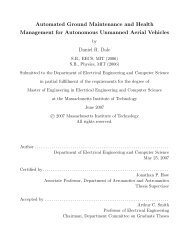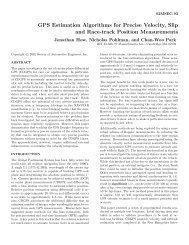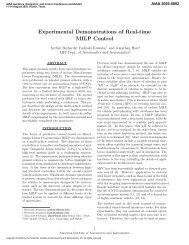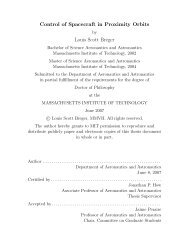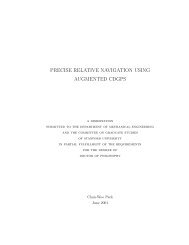Robust UAV Search for Environments with Imprecise Probability Maps
Robust UAV Search for Environments with Imprecise Probability Maps
Robust UAV Search for Environments with Imprecise Probability Maps
You also want an ePaper? Increase the reach of your titles
YUMPU automatically turns print PDFs into web optimized ePapers that Google loves.
Since the probability of a correct detection is the probability<br />
of a target being detected by the sensor when there is a<br />
target present in a cell, this can be estimated over a set of<br />
measurements, N, as<br />
ξ ≈ γ 1<br />
(10)<br />
N<br />
where γ 1 indicates the number of measurements indicating<br />
a target was detected in the cell. Hence, γ 1 ≈ Nξ. This can<br />
be combined <strong>with</strong> Eq. 9 to solve <strong>for</strong> the total number of<br />
measurements (or “looks” in the cell) explicitly. Substituting<br />
this result in Eq. (9) and solving <strong>for</strong> N<br />
(α − 1)b + αc<br />
N ≥ (11)<br />
ξ − α<br />
The key appeal of this result is that it relates the initial<br />
condition of the distribution (summarized by b and c) and<br />
sensor accuracy (ξ), to the objective α. This <strong>for</strong>mulation<br />
only relies on the first moment of the distribution, since it<br />
is based on achieving a certain threshold on the expected<br />
value. It does not consider the entire distribution, which<br />
could be undesirable. For example, <strong>with</strong> the number of looks<br />
expressed in Result A, an operator may want the posterior<br />
distribution to be tightly distributed about the mean, while<br />
exceeding the threshold. This will ensure that there is a<br />
much higher “certainty” about the mean. Thus, we are also<br />
interested in a result that incorporates the tightness of the<br />
distribution, in a similar approach to that used in Ref. [4].<br />
Hence a new <strong>for</strong>mulation that includes a variance term is<br />
presented.<br />
Objective B1: <strong>Robust</strong> <strong>Search</strong> Formulation Find the number<br />
of looks required to raise the expected value of the<br />
posterior distribution to exceed a threshold η (subject to a<br />
penalty of uncertainty, σ, and a robustness parameter µ)<br />
{ min N | ¯x(N) − µσ(N) ≥ η } (12)<br />
Result B1: The number of looks required in a “robust”<br />
search problem is given by the solution to the following cubic<br />
equation<br />
G 3 N 3 + G 2 N 2 + G 1 N + G 0 ≥ 0 (13)<br />
where G i ∀i =0, 1, 2, 3 are constant parameters.<br />
Proof: Since the expected value is given by<br />
b + γ 1<br />
¯x =<br />
=<br />
b + Nξ<br />
b + c + γ 1 + γ 2 b + c + N<br />
and the standard deviation is<br />
√<br />
(b + γ 1 )(c + γ 2 )<br />
σ =<br />
(b + c + N) 2 (b + c +1+N)<br />
√<br />
1 (b + Nξ)(c + N(1 − ξ))<br />
=<br />
b + c + N b + c +1+N<br />
The optimization is to find the minimum N such that<br />
b + Nξ<br />
b + c + N − µ 1<br />
b + c + N<br />
(14)<br />
(15)<br />
√<br />
(b + Nξ)(c + N(1 − ξ))<br />
≥ η<br />
b + c +1+N<br />
(16)<br />
Cubic function<br />
1200<br />
1000<br />
800<br />
600<br />
400<br />
200<br />
0<br />
µ 1<br />
= 0.1; µ 2<br />
= 0.2; µ 3<br />
= 0.3<br />
µ 1<br />
µ 2<br />
µ 3<br />
12 14 16 18 20 22 24<br />
N, number of looks<br />
Fig. 2. A plot of the cubic function of µ. The result shows that as a<br />
greater confidence is required (from µ =0.1 to µ =0.3), the number of<br />
looks increases, from approximately 17 to 24. All cases shown were <strong>with</strong><br />
ξ =0.85, η =0.8, and initial uni<strong>for</strong>m distribution (b =1, c =1).<br />
which, after some algebra, results in the cubic equation that<br />
must be solved <strong>for</strong> N<br />
where<br />
G 3 N 3 + G 2 N 2 + G 1 N + G 0 ≥ 0 (17)<br />
G 3 = (η − ξ) 2<br />
G 2 = M (η − ξ) 2 +2L(η − ξ) − µ 2 ξ(1 − ξ)<br />
G 1 = 2LM(η − ξ)+L 2 − µ 2 (ξc + b(1 − ξ))<br />
G 0 = ML 2 − µ 2 bc<br />
L = (b + c)η − b<br />
M = b + c +1<br />
Intuitively, any <strong>for</strong>m of this result where µ>0 will result in<br />
a greater number of looks in the particular region of interest<br />
than <strong>for</strong> µ =0. This effect is shown in Figure 2, where three<br />
sample cubic functions were plotted directly as a function of<br />
the number of looks N, <strong>for</strong>varyingµ. It is clear from this<br />
figure that as the tuning parameter, µ, is increased (a much<br />
tighter posterior distribution is desired), the number of looks<br />
required to achieve the same threshold η increases.<br />
Remark 1 (Results A and B): In Objectives A and B, results<br />
<strong>for</strong> the number of looks were only presented <strong>for</strong> the case<br />
when the target was present. Of course an analogous set<br />
exist that indicate the number of looks that should be made<br />
in a cell to declare that a target is not present in a cell. A<br />
mission designer would then use the maximum number of<br />
looks of the two <strong>for</strong>mulations to unambiguously declare the<br />
existence or absence of a target.<br />
Remark 2 (Result A): The fundamental constraint <strong>for</strong> Result<br />
A to be valid is that N>0, and the non-trivial inequality<br />
that must be satisfied by the solution <strong>for</strong> N is<br />
ξ>α><br />
b<br />
b + c<br />
It displays the interesting property that the parameter α<br />
cannot be chosen arbitrarily, and is constrained by the sensor<br />
5683



